评估应用于门禁控制的 VLC 系统中作为接收器的太阳能电池板 AGC
IF 1.3
4区 工程技术
Q3 COMPUTER SCIENCE, INFORMATION SYSTEMS
引用次数: 0
摘要
可见光通信(VLC)技术可利用发光二极管(LED)发出的光功率传输数据。光接收器通常采用光传感器,如光电二极管、图像传感器、光敏电阻或太阳能电池板。在过去的几十年里,VLC 技术一直在探索使用太阳能电池板作为数据接收器,因为太阳能电池板除了提供发电服务外,还能提供更大的表面积来捕捉光束。本文介绍了基于太阳能电池板和自动增益控制(AGC)的 VLC 系统的性能评估,该系统可应用于门禁系统。本文提出了三个实验来评估太阳能电池板在 VLC 系统中作为信息接收器的用途:带宽(BW)估算、VLC 系统性能和电池板视角变化。结果,考虑到面板不带 AGC 和带 AGC,我们能够确定 10 kHz 和 190 kHz 的带宽。在数字调制方面,我们使用了 Arduino UNO 开发系统的 RS-232 模块来执行强度调制和直接检测 IM/DD 技术。串行接口的 NRZ 行码用于调制 LED 的电流,最大符号率为 38400 波特,数据有效率为 91%。此外,我们还发现 AGC 可改善太阳能电池板视角的动态范围和 VLC 系统的性能。本文章由计算机程序翻译,如有差异,请以英文原文为准。
Evaluation of an AGC for a Solar Panel as a Receiver in a VLC System Applied to Access Control
Visible light communication (VLC) technology allows data to be transmitted using the optical power emitted by light-emitting diodes (LEDs). The optical receiver usually employs light sensors such as photodiodes, image sensors, photoresistors or solar panel. In the last decades, VLC technology has explored the use of solar panels as data receivers, since they offer the service of power generation, in addition to, a larger surface area to capture the light beam. In this paper, we present the performance evaluation of a VLC system based on solar panel and automatic gain control (AGC) with application in access control systems. Three experiments are proposed to evaluate the uses of the solar panel as information receiver in VLC systems: bandwidth (BW) estimation, VLC system performance and panel viewing angle variation. As a result, we were able to determine a BW of 10 kHz and 190 kHz considering the panel without AGC and with AGC. In the context of digital modulation, a RS-232 module of an Arduino UNO development system was used in order to execute the technique of intensity modulation and direct detection IM/DD. The NRZ line code of the serial interface was used to modulate the electric current of the LED with a maximum symbol rate of 38400 baud with a data effectiveness of 91%. Furthermore, we found that AGC improves the dynamic range of the solar panel's viewing angle and the performance of the VLC system.
求助全文
通过发布文献求助,成功后即可免费获取论文全文。
去求助
来源期刊

IEEE Latin America Transactions
COMPUTER SCIENCE, INFORMATION SYSTEMS-ENGINEERING, ELECTRICAL & ELECTRONIC
CiteScore
3.50
自引率
7.70%
发文量
192
审稿时长
3-8 weeks
期刊介绍:
IEEE Latin America Transactions (IEEE LATAM) is an interdisciplinary journal focused on the dissemination of original and quality research papers / review articles in Spanish and Portuguese of emerging topics in three main areas: Computing, Electric Energy and Electronics. Some of the sub-areas of the journal are, but not limited to: Automatic control, communications, instrumentation, artificial intelligence, power and industrial electronics, fault diagnosis and detection, transportation electrification, internet of things, electrical machines, circuits and systems, biomedicine and biomedical / haptic applications, secure communications, robotics, sensors and actuators, computer networks, smart grids, among others.
 求助内容:
求助内容: 应助结果提醒方式:
应助结果提醒方式:


